Successful inbound plays from the ‘dead corner’
As coaches, we sit around and try to figure out ways to execute inbound plays for many different game situations. When I talk about out-of-bounds plays, I refer to them as special teams situations, much like football.
One area of the floor that is often overlooked is inbounding the ball from the “dead corner.” Another situation that is different is developing inbound plays that allow you to score. The special teams situation has to do with trying to score from the dead corner.
Diagonal skip
The first play has many options to allow your post player to score, and it also develops a shot on the weak-side wing.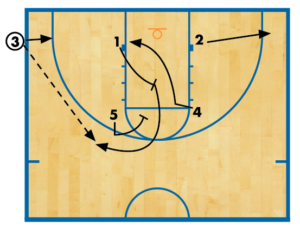 DIAGRAM 1: Diagonal skip (A). This play starts with 3 inbounding the ball from the dead corner. 1 and 2 are set up on the left and right blocks while 4 and 5 are set up on the left and right elbows in a box alignment.
DIAGRAM 1: Diagonal skip (A). This play starts with 3 inbounding the ball from the dead corner. 1 and 2 are set up on the left and right blocks while 4 and 5 are set up on the left and right elbows in a box alignment.
As 3 waits to inbound the ball, 2 breaks to the right corner. 1 then sets a diagonal screen for 4 to bring him or her to the left block. 5 then sets a screen for 1 (screen the screener) to get the ball. You want to get the ball to 4 if that player is open on the initial screen by 1. 3 steps in.
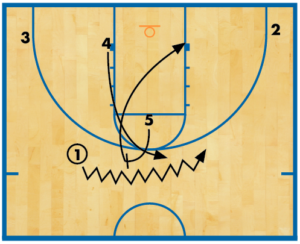 DIAGRAM 2: Diagonal skip (B). 5 turns and sets a high ball screen for 1. 5 then rolls to the right-side block and 4 runs to the top of the key.
DIAGRAM 2: Diagonal skip (B). 5 turns and sets a high ball screen for 1. 5 then rolls to the right-side block and 4 runs to the top of the key.
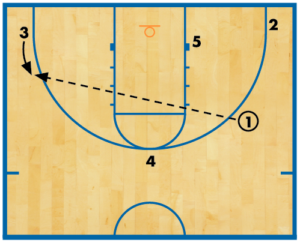 DIAGRAM 3: Diagonal skip (C). 1 will drag 5’s defender away from the screen. 4’s defender likely will switch onto 5 rolling and 3’s defender will give weak-side help. If 5 is not open then 1 will skip to 3 for the open shot.
DIAGRAM 3: Diagonal skip (C). 1 will drag 5’s defender away from the screen. 4’s defender likely will switch onto 5 rolling and 3’s defender will give weak-side help. If 5 is not open then 1 will skip to 3 for the open shot.
Guard iso
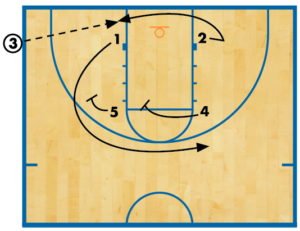 DIAGRAM 4: Guard iso (A). Like the diagonal skip, guard iso has multiple options. The alignment is the same as diagonal skip, only this time as the ball is being inbounded by 3, 5 and 4 will set a staggered double screen for 1 going away and clearing the way for 2 to post up on the left-side block (isolation because 2’s man probably will front the post).
DIAGRAM 4: Guard iso (A). Like the diagonal skip, guard iso has multiple options. The alignment is the same as diagonal skip, only this time as the ball is being inbounded by 3, 5 and 4 will set a staggered double screen for 1 going away and clearing the way for 2 to post up on the left-side block (isolation because 2’s man probably will front the post).
 DIAGRAM 5: Guard iso (B). If 3 is unable to get 2 the ball on a post up, he or she then inbounds the ball to 5 and gets a dribble handoff from 5.
DIAGRAM 5: Guard iso (B). If 3 is unable to get 2 the ball on a post up, he or she then inbounds the ball to 5 and gets a dribble handoff from 5.
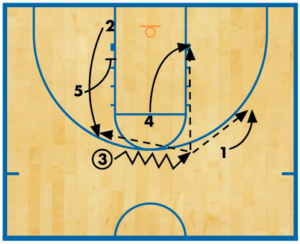 DIAGRAM 6: Guard iso (C). 4 dives to the right-side block looking for a slip pass or 3 will look for 2 who gets a down screen from 5 for the shot. 3 also can look at 1 to make a pass to 4 slipping.
DIAGRAM 6: Guard iso (C). 4 dives to the right-side block looking for a slip pass or 3 will look for 2 who gets a down screen from 5 for the shot. 3 also can look at 1 to make a pass to 4 slipping.
Baseline triple
 DIAGRAM 7: Baseline triple (A). This plan also provides your offense with many scoring opportunities. The alignment is the same as diagonal skip and guard iso, only this time as the ball is inbounded by 3, 1 clears to the right wing and 2 comes off a double screen set by 5 and 4 and receives a pass from 3.
DIAGRAM 7: Baseline triple (A). This plan also provides your offense with many scoring opportunities. The alignment is the same as diagonal skip and guard iso, only this time as the ball is inbounded by 3, 1 clears to the right wing and 2 comes off a double screen set by 5 and 4 and receives a pass from 3.
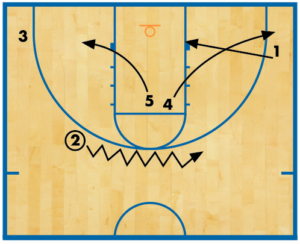 DIAGRAM 8: Baseline triple (B). 3 steps into the left corner. 5 cuts to the mid corner on the left side and 4 cuts into the corner on the right side. 1 cuts to the right-side block.
DIAGRAM 8: Baseline triple (B). 3 steps into the left corner. 5 cuts to the mid corner on the left side and 4 cuts into the corner on the right side. 1 cuts to the right-side block.
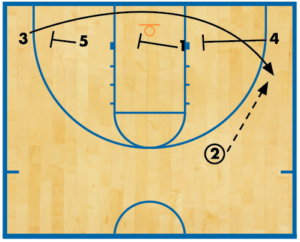 DIAGRAM 9: Baseline triple (C). 3 comes off a triple staggered screen on the baseline looking for a shot. 2, who has the ball at the top, will read 4’s defender if they hedge out too far and slip in a pass.
DIAGRAM 9: Baseline triple (C). 3 comes off a triple staggered screen on the baseline looking for a shot. 2, who has the ball at the top, will read 4’s defender if they hedge out too far and slip in a pass.
All three plays have good action, as they are designed to get scoring opportunities for different personnel on your team. When coaches draw up plays, they always try and get the ball inbounds. Why not take it one step further and try to score?
We want to try and get as many easy baskets as possible. You often hear football coaches say they have to win the battle of special teams. So why not win the battle of special teams in basketball by designing plays to help you score when the defense doesn’t expect it?









